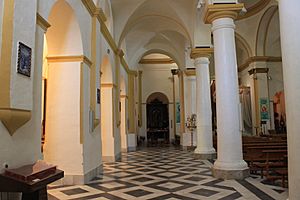Church of Nuestra Señora de la Palma, Algeciras facts for kids
Quick facts for kids Church of Our Lady of the PalmIglesia de Nuestra Señora de la Palma |
|
|---|---|

The Church of Our Lady of the Palm is a famous landmark in the Plaza Alta square.
|
|
| 36°7′51.22″N 5°26′51.84″W / 36.1308944°N 5.4477333°W | |
| Location | Algeciras |
| Country | Spain |
| Denomination | Roman Catholic |
| History | |
| Status | Parish church |
| Consecrated | 6 June 1738 |
| Architecture | |
| Functional status | Active |
| Heritage designation | Bien de Interés Cultural |
| Designated | 4 July 1992 |
| Architect(s) | Alonso Barranco, Isidro Casaus |
| Groundbreaking | 1723 |
| Completed | 1738 |
| Specifications | |
| Number of spires | 1 |
| Spire height | 150 ft (46 m) |
| Administration | |
| Archdiocese | Archdiocese of Seville |
| Diocese | Cadiz and Ceuta |
The Church of Our Lady of the Palm (in Spanish, Iglesia de Nuestra Señora de la Palma) is a Roman Catholic church in the city of Algeciras, Spain. It stands on a famous square called the Plaza Alta.
The church is a very important landmark in the city. In 1992, the Spanish government listed it as a Bien de Interes Cultural, which means it is a special site of cultural importance that must be protected.
Contents
History of the Church
The church is dedicated to Santa María de la Palma, which means Saint Mary of the Palm. This name was chosen because King Alfonso XI of Castile conquered Algeciras on Palm Sunday in the year 1344.
From a Mosque to a Church
After the king's victory, Pope Clement VI turned the city's main mosque into a Christian church. For a while, Algeciras had its own church district, called a diocese.
However, this did not last long. In 1368, the Moors, a group from North Africa, recaptured the city. On the orders of their ruler, Muhammed V of Granada, the city and the church were destroyed.
Rebuilding a Landmark
For centuries, the city had only a small chapel. By the 1700s, the population of Algeciras had grown so much that the chapel was too small for everyone. So, in 1723, work began on a new, larger church—the one that stands today.
The church was built with money donated by the people of the city. It was finished in 1738. On June 6 of that year, it officially became the main parish church of Algeciras.
In 1923, to celebrate the church's 200th anniversary, Pope Pius XI made Santa María de la Palma a special protector, or patron saint, of Algeciras.
Architecture and Design
The Church of Our Lady of the Palm has a beautiful and historic design. It was built over many years, with different parts added at different times.
What Does the Church Look Like?
Originally, the church had a central hall, called a nave, and two side sections, called aisles. In 1795, two more small aisles were added. The main nave has a high, curved ceiling known as a barrel vault. Thick Doric columns separate the nave from the aisles.
The church's bell tower is very tall, standing at 150 feet (about 46 meters). It was built between 1793 and 1804. To build it, workers used stones from the old city walls that had been torn down. If you look closely at the tower, you can still see special marks made by the original stonemasons.
The front of the church has strong supports called buttresses on each side of the main door. Above the door, there is a small carved space, or niche, with a statue of the Virgin Mary.
Inside the Church
Inside, you can find a special sculpture of Mary made from alabaster, a type of white stone. The sculpture was made in Italy in the 18th century. According to a local story, the sculpture was on a ship that was stuck in the port because of a storm. The people believed the storm would not stop until the statue was brought ashore to the church.
Sadly, some of the church's treasures were damaged or lost during a time of unrest in 1931. The beautiful sculpture was badly broken but was later repaired. However, the church's main altar and other valuable items were lost forever.
Today, the inside of the church has been fully restored and cleaned. It has a simple and peaceful look, with fewer decorations than it had in the past.
See also
 In Spanish: Iglesia de Nuestra Señora de la Palma para niños
In Spanish: Iglesia de Nuestra Señora de la Palma para niños


